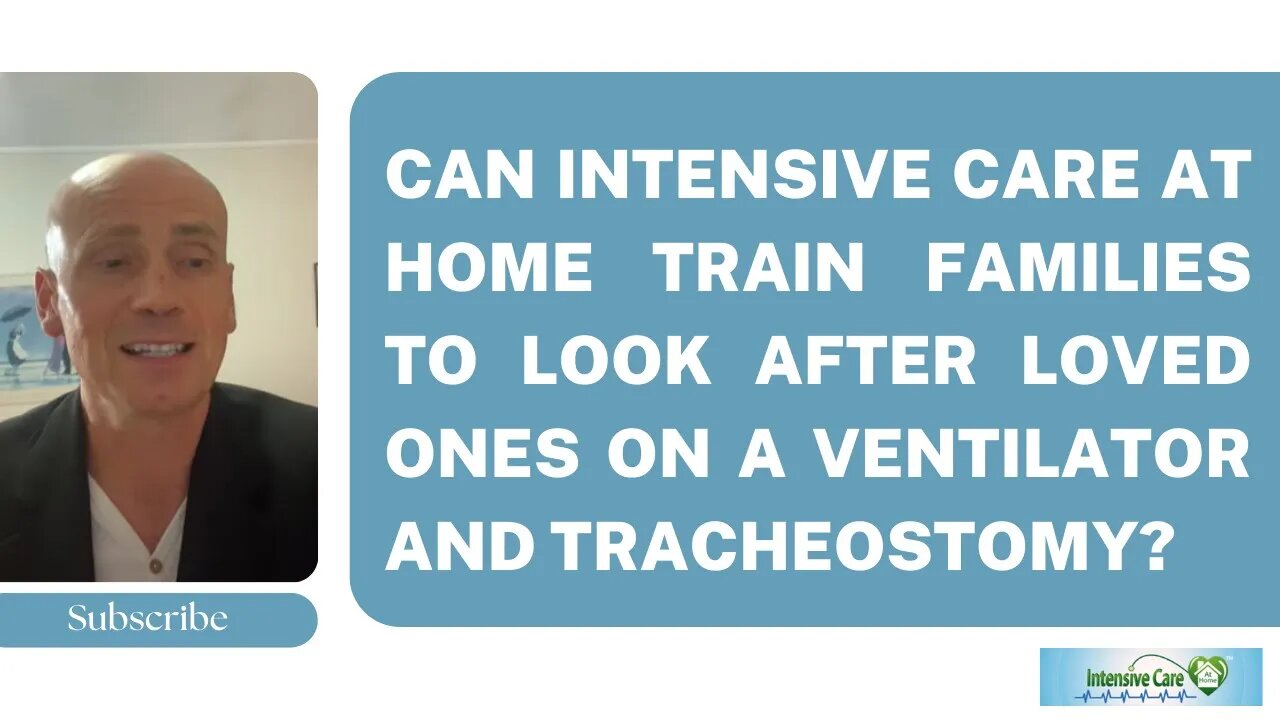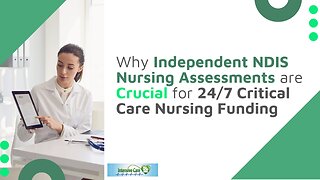Premium Only Content

CAN INTENSIVE CARE AT HOME TRAIN FAMILIES TO LOOK AFTER LOVED ONES ON A VENTILATOR and TRACHEOSTOMY?
CAN INTENSIVE CARE AT HOME TRAIN FAMILY MEMBERS TO LOOK AFTER THEIR LOVED ONES ON A VENTILATOR AND A TRACHEOSTOMY?
Book your free 15-minute phone consultation here
http://intensivecarehotline.com/scheduling-appointment/
Call directly 24/7
+1 415-915-0090 USA/Canada
+44 118 324 3018 UK
+6141 094 2230 Australia
Email support@intensivecarehotline.com
Get 1:1 consulting and advocacy
1:1 phone counselling
http://intensivecarehotline.com/one-on-one-counselling/
Become a member for families of critically ill Patients in Intensive Care
https://intensivecarehotline.com/intensivecaresupport-org-membership/
Immediate action steps http://intensivecarehotline.com/take-control-take-charge/immediate-action-steps/
https://intensivecareathome.com
And if you need a medical record review, click on the link and we can help you with reviewing your loved one’s medical records while they’re in ICU.
https://intensivecarehotline.thrivecart.com/review-of-medical-records/
Facebook Page: https://www.facebook.com/ICUhotline
Twitter: https://twitter.com/icuhotline
#icu
#intensivecare
#criticalcare
So in today’s blog post, I want to talk about,
Can Intensive Care at Home Train Family Members to Look After their Loved Ones on a Ventilator and a Tracheostomy?
This is a question we get very often from families that come to us that have a loved one in intensive care, or have a loved one at home on a ventilator with a tracheostomy, whether we can train them. They also asked that question if their loved ones only have a tracheostomy or are ventilated with BiPAP, CPAP and don’t have a tracheostomy. Now, the short answer to this question is a clear no, and I will evaluate on that.
Can Intensive Care at Home Train Family Members to Look After their Loved Ones on a Ventilator and a Tracheostomy?
So when someone is having a tracheostomy, is having a ventilator, it takes years of training to look after someone on a ventilator with the tracheostomy. It also takes years of training to look after someone with a tracheostomy.
Now, I would argue that 99% of patients with a tracheostomy when in hospital are in intensive care and in intensive care, doctors, nurses, etc., need to go through specialized training, to work in intensive care and that includes looking after ventilator, looking after tracheostomy.
The reason why someone is in intensive care, if they’re on a ventilator and a tracheostomy is simply that their life is in danger and that it takes those specialist skills to manage, maintain a ventilator/tracheostomy. The risk for a medical emergency is huge when someone has an artificial airway, because that is what a tracheostomy is.
Also if someone is ventilated without a tracheostomy and they’re on BiPAP or CPAP ventilation, they’re still on a mechanical ventilator and the reality is, that the risk that something goes wrong when someone is on a ventilator is fairly high. And therefore, people need to know what they’re doing.
The best analogy that I can make is, when someone is on a ventilator and a tracheostomy or both, if you’re not having intensive care nurses or intensive care doctors manage that, it’s like flying a plane with a cabin crew and not with a pilot.
So therefore we are unable to train families because you need to understand anatomy. You need to understand physiology. You need to have seen emergencies and how to successfully manage them. And unless you’ve done this numerous times, like we all have here at Intensive Care at Home where we employ hundreds of years of intensive care nursing experience. We just can’t pass on that intellectual property in a quick training session because as I mentioned, this takes years of experience.
I’ll give you some practical examples so you can understand why I’m saying what I’m saying. Number one, on our website at intensivecareathome.com, we have published the home mechanical ventilation guidelines. Now, if you look at the home mechanical ventilation guidelines, it clearly demands not suggests, it clearly demands that when someone is having a ventilator and/or a tracheostomy at home, they need to be intensive care nurses/critical care nurses, 24 hours a day full stop.
Now, those guidelines are a result of having performed intensive care at home services for the last 25 years, predominantly in German speaking countries but now also in Australia for the last seven years where we have certainly proven our concept here without a shadow of a doubt...
Continue reading at: https://intensivecareathome.com/can-intensive-care-at-home-train-family-members-to-look-after-their-loved-ones-on-a-ventilator-and-a-tracheostomy/
-
 16:51
16:51
Intensive Care at Home
16 days agoWhy Independent NDIS Nursing Assessments are Crucial for 24/7 Critical Care Nursing Funding
121 -
 LIVE
LIVE
Awaken With JP
1 hour agoTrans Shooter is the Victim, Vaccines in Trouble, and Greta is Ugly - LIES Ep 106
762 watching -
 LIVE
LIVE
The White House
5 hours agoPresident Trump Makes an Announcement, Sep. 2, 2025
1,743 watching -
 LIVE
LIVE
MattMorseTV
2 hours ago $2.68 earned🔴Trump's Oval Office BOMBSHELL.🔴
1,477 watching -
 18:14
18:14
Real Estate
14 hours agoRising Prices PUSHING AMERICANS OVER THE EDGE
36 -
 1:43:35
1:43:35
Russell Brand
2 hours agoTrump Demands Big Pharma PROVE Covid Vaccine Is Safe – Did Pfizer LIE?! - SF626
106K25 -
 LIVE
LIVE
Due Dissidence
4 hours agoIsrael THREATENS Greta, InfoWars Host QUITS, FL Losing $200M on EMPTYING Alligator Alcatraz
779 watching -

Law&Crime
6 hours ago $0.41 earnedLIVE: Adelson Matriarch Murder Trial — FL v. Donna Adelson — Day 6
2.98K -
 1:08:04
1:08:04
Sean Unpaved
3 hours agoGridiron Shocks: Arch's Rough Start, Belichick's Tar Heel Tumble, & NFL Week 1 Buzz
20.3K -
 LIVE
LIVE
Professor Nez
1 hour ago🚨🇺🇸President Trump makes MAJOR Announcement from Oval Office TODAY!
285 watching